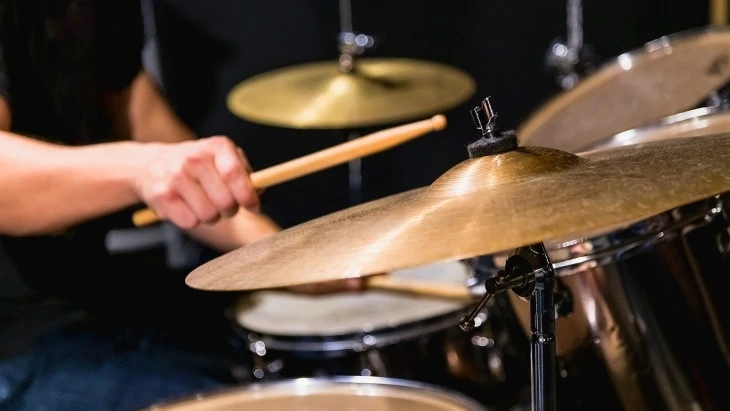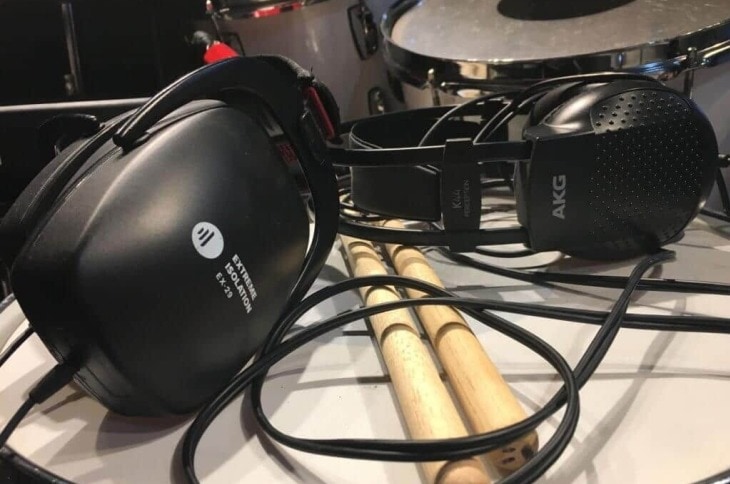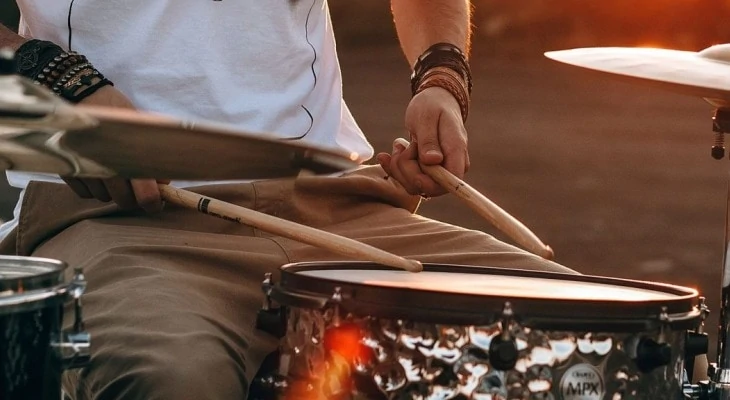Drums are one of the coolest instruments around. Drummers have a reputation for being the cool guys in bands who are easy-going, adventurous, and great to get along with.
Modern technology has made it easier than ever to pick up some drum sticks and start learning. However, it can be pretty daunting. With all those drums and all the readily available information, where do you start? I’m here to help you figure that out.
Table of Contents
Get a Drum Kit

The first thing to do would be to get yourself a drum kit. Although you can learn some things with just a pair of sticks, whatever you play with those will never feel as rewarding as playing on a full-sized drum set.
There are many affordable kits out there that are specifically designed for beginners. They come with everything you need, including the drums, hardware, and cymbals. I personally recommend the Pearl Roadshow kit for beginners.
If you get a kit that is a bit more expensive, just know that you may need to buy hardware and cymbals separately as all the best kits only get sold in shell packs.
In terms of what type of kit to get, a standard 5-piece set is a great starting point. Having a snare drum, two rack toms, a floor tom, and a bass drum is the standard way of playing and most drum lessons you see will want you to incorporate these drums.
Learn Basic Drum Notation
The best thing you could do for yourself before learning anything on the drums is to learn how to read basic drum notation. Having this ability will make the learning process a lot smoother as many drum lessons will have sheet music to go along with them.
It’s the same thing as learning the alphabet so that you can read a book that will teach you how to do something.
You don’t need to go in-depth with notation in the beginning. You just need to know about quarter notes, 8th notes, and 16th notes. You also need to know which drums are placed where in a bar of music.
Once you’ve got that information in your head, you can easily read and play basic drum beats and fills. The trick now would be getting your limbs to work comfortably together.
Beats

The purpose of a drummer in a band is to provide the groove. So, the main thing you will do as a drummer is playing drum beats. Once you’ve learned the basics of drum notation. You can find some drum beats to learn.
The first drum beat that everyone learns is called a basic rock groove. It can be heard on many songs since it is such a versatile groove.
Most beats are just variations of that first rock beat. So, once you have that beat down, start adding more bass drum notes into the mix or double up your hands here and there. When you’re comfortable with doing that, you can start delving into the world of ghost notes.
Ghost notes are soft notes played on the snare drum. They subtly make beats feel a lot more groovy. Learning to play ghost notes will be a giant step towards playing drums like a pro.
Fills
Once you can play a few grooves, you can learn how to play drum fills. These are the patterns played around the drums to end off phrases of music. There is an infinite amount of drum fills to play, so it can get quite daunting to start. However, it’s best to just start playing straight notes around the drums and get good at playing those.
Once you can do that, you can start to experiment with different patterns and rhythms. The trick now is to incorporate the drum fills after you’ve played a few bars of a groove. This may be difficult at first, but you’ll get used to it eventually. Using a metronome may help a lot with this.
Once you can play a few basic beats and fills, you’re going to feel pretty accomplished on the drums. Now you can take those skills and apply them to music.
Play to Music

Every pro drummer will tell you that the best way to improve on the drums is to play to music. This is because you’re taking your skills and applying them to real musical situations, allowing you to see what works and what doesn’t, and letting you develop a sense of musicality behind the kit.
As said before, the whole point of playing the drums is to accompany the music, so playing to music is one of the most important things you can do. Luckily, it’s a load of fun! There are many songs out there that are easy to play along with, even for beginner drummers. Songs like We Will Rock You and Billie Jean are fantastic starting points.
A great way to train yourself to play is to listen to the song and then try to imitate the drumbeat that you heard. If you can do that, you’re well on your way to becoming a professional drummer.
Check Out Available Resources
There are so many free sources of information on the internet that will help you learn to play. With thousands of drum lessons on YouTube, you have more access to educational material than any drummer before you has had. So, make good use of it.
If you’ve run out of beats to play, do a quick Google search and find some more. Do the same thing with drum fills. You could probably even find someone teaching you how to play your favorite song on the drums.
One thing I will say is that the problem with free online education is that you won’t get any feedback. This won’t matter for some people, but other people might develop bad habits on the drums without anyone ever correcting them. So, if you can find a drum teacher that will keep you accountable in person, you’ll be golden.
Develop a Steady Routine
Once you’ve learned a few things and you steadily start to work on improving, it’s vitally important to develop a steady practice routine. This will keep you motivated and allow you to track your progress and improvement.
Your practice routine should consist of exercises to develop your technique, playing along with music, learning something you can’t play already, and free jamming to keep you enjoying the process of playing the drums.
Conclusion
One thing that is important to remember is that learning to play this instrument is a long game. No one becomes a pro drummer overnight. However, with a steady practice routine and a smart practice plan, you’ll be able to develop many skills on the drums in a relatively short amount of time.
The best thing you can do is to listen to a lot of music. This will give you a perspective on how pro drummers play. You may get inspired and want to learn what they play. Great! That’s the best place to start.
So, get a drum kit, understand basic drum notation, work on some beats and fills, play along to music, and you’ll be well on your way to smashing it out with the best of them.

